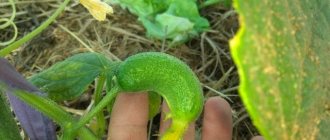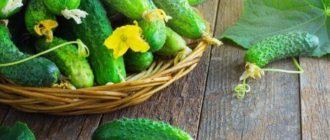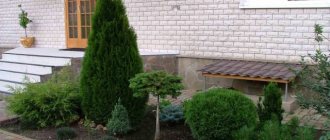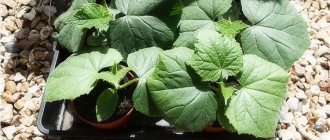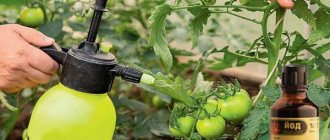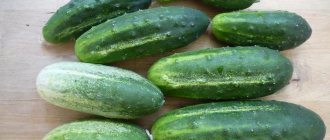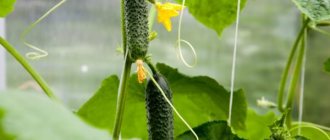How to feed cucumber seedlings on a windowsill at home before planting them in the ground will be discussed in this article, because many vegetable growers first grow cucumber seedlings before planting them in open ground.
To grow strong and healthy shoots at home, they need feeding. Although this process is not difficult, it does require effort. In this article, in addition to the rules for applying fertilizers for cucumbers, you will learn about many secrets of their cultivation.
How to understand that cucumbers on the windowsill need feeding: signs of plants
It is difficult to grow cucumbers in an apartment without organic fertilizers and fertilizing. For fruit development, the main elements are potassium, nitrogen and phosphorus.
To understand which mineral elements are not enough, pay attention to the state of the green mass, inflorescences and cucumbers in the table below:
| Element | Leaves | Escapes | Flowers | Fruit |
| Potassium | Dark green with a yellow border around it | Elongated | They fall without an ovary | Watery and bitter in taste |
| Nitrogen | New ones do not grow, old ones turn light yellow and fall off | There is no formation of new ones, weakening of old ones | The number of inflorescences is reduced | Small and deformed with a bent nose |
| Phosphorus | Small and dense dark green with watery spots | New growth slows down | Ovary missing | Slow formation |
In addition to potassium, phosphorus and nitrogen, cucumbers require other minerals. Their absence is reflected in the appearance of the plant. Signs of deficiency:
- bora - fall of flowers and ovaries, a light stripe on the curved shape of the fruit;
- magnesium – uneven coloring of leaves, appearance of light and dark spots;
- manganese - pale leaves with dark green veins;
- calcium - yellow and dried leaf frame.
If you are interested in growing fruit crops on a windowsill, I will tell you how to plant cucumbers. Read and expand your knowledge!
Why do you need feeding?
Feeding cucumber seedlings grown at home is required due to the fact that the plants feed on beneficial elements from the soil, which over time depletes the soil. Sprouts, lacking certain substances, begin to wither despite quality care.
Provide a constant supply of nutrients with regular supplements that actively affect:
- development of the root system;
- growth of cucumber seedlings;
- formation of flowers and ovaries;
- size and taste of cucumbers;
- duration of the fruiting period.
Indoor cucumbers can indicate by their appearance that they urgently need feeding:
- leaves dry out;
- the fruits turn yellow and die while still small;
- The shape of cucumbers is hook-shaped.
In order for the seedlings to be healthy and strong, the soil must constantly be fed with fertilizers important for development and growth. Otherwise, it will be simply impossible to grow large and tasty cucumbers not only on the windowsill, but also in the greenhouse.
When to fertilize cucumbers when growing at home
Feeding cucumbers on the windowsill at home helps them grow and form fruits. I begin to apply mineral fertilizers already when planting seeds.
So, how and when to fertilize cucumbers on the windowsill:
- 14 days after emergence, I add 10 g of urea and superphosphate per 3 liters of warm water (60 ml per bush).
- I carry out the second feeding 10 days after the first. I make a solution at the rate of: 100 g of urea per 10 liters of water (100 ml per bush).
- 10 days after applying the previous fertilizer, I prepared a solution at the rate of: 30 g of wood ash and nitrophoska per 3 liters of water (150-200 ml per bush).
Author's note
Natalia Papanova
Blog author
To prevent acidification and improve the soil between the second and third stages, feed the soil with peat.
If you don’t know how to fertilize the cucumbers on the balcony during fruiting, I’ll tell you what to feed them to get a good harvest.
Watch the video: first feeding of cucumbers:
How and how to fertilize cucumber seedlings
Applying fertilizers to cucumber seedlings is not difficult if you know which ones to use and follow the proportions. A young developing crop that has not yet bloomed or bear fruit needs to be fed with nitrogen, calcium and phosphorus. Urea can be used. When forming cucumbers, you will already need fertilizing with a different composition: magnesium, potassium and an increased amount of nitrogen.
Some gardeners buy ready-made complex mineral mixtures containing all the necessary nutrients for cucumber seedlings growing at home. Instructions for use are always included with such mixtures. Others adhere to traditional natural fertilizers, using traditional methods of fertilizing, because... they don’t want to use chemicals - this is more labor-intensive, but it also allows you to achieve good cucumber yields.
Types of fertilizers for indoor cucumbers
Among the types of fertilizers for cucumbers, I would like to mention the organic fertilizers azofoska and wood ash. Foliar treatments of bushes with a solution of boron, manganese and iodine also help to form ovaries and improve productivity. Folk remedies are less harmful than inorganic fertilizers.
Organic fertilizers
Azofoska is a multi-purpose fertilizer that includes valuable minerals nitrogen, potassium and phosphorus and up to 16% of other essential micro and macroelements. I add 3 g of azofoska per 3 liters of water, stir and water once every 2 weeks (200 ml for each bush).
Wood ash is an organic fertilizer that is used to fertilize any vegetable crops. I dilute the crushed ash with water at the rate of 1 glass per 10 liters of water and water it (1 bush 1 liter of solution).
Wood ash is the best organic fertilizer for cucumbers
Foliar treatment
At the stage of ovary formation, boron is an important element. When the first shoots began to bloom, I prepared a solution at the rate of 1 g of boric acid per 1 liter of water and treated the plant with a spray bottle. In the future I will carry out the procedure every 10 days.
The next essential mineral for cucumbers is manganese. Foliar treatment improves the taste of the fruit and prevents the development of mold. I took a teaspoon of potassium permanganate on the tip and diluted it in a liter of water. Sprayed a day after treatment with a solution of boric acid. You can replace manganese with urea at the rate of 5 g per 3 liters of water.
At the flowering stage, when three or four leaves appear, I spray the cucumbers with iodine solution. I mix 15 drops of iodine, 0.5 liters of milk and 5 liters of water. I process during the active growing season.
Did you find out how to carry out foliar treatment? Now feel free to read the article about growing cucumbers on a loggia!
Folk remedies
Banana peels contain a high percentage of potassium. I dried the fruit peelings in the oven, then crushed them and sprinkled them into the soil before watering. You can simply soak the peel in water for four days, then apply it under each bush.
Eggshells include at least 27 microelements, including copper, fluorine, sulfur, zinc, manganese, and phosphorus. This set of useful minerals will replace any inorganic fertilizers. I crushed the shells of four eggs and added 3 liters of warm water. After three days, I spray the cucumbers and water the bushes at the root with the prepared solution. The only drawback of this feeding is the unpleasant smell of hydrogen sulfide.
Onion peels and potato peelings are excellent as fertilizer. I added 1 liter of hot water to the husk mixture and left it for 5 days. Then I use it for foliar feeding, having first filtered it. I filled the potato peelings with warm water in the evening and watered the soil in the morning.
Sugar is also a great food for cucumbers. I pour one teaspoon onto the soil, then water it. You can simply dilute it in a liter of warm water.
Crushed eggshells are a folk remedy for fertilizing cucumbers.
Natural fertilizers for cucumber seedlings
Some gardeners completely abandon chemicals and organics in favor of natural fertilizers based on folk recipes, while others use natural fertilizers only as additional ones. However, it is important to maintain proportions in both mineral and natural fertilizers, otherwise, instead of benefiting, you can quickly destroy all the plants without a chance of recovery.
Banana peels
Banana peel is known for its high potassium content, which is so necessary for small cucumbers growing at home. In addition to potassium, the skin contains many other important elements. The peel, prepared by drying, infusing in water or otherwise, is applied under the seedling bushes. In powder form, 1 tsp is enough. on the sprout, after two days the infusion is poured as with normal watering.
It should be remembered that the peel may contain harmful chemicals in addition to nutrients. Therefore, the skins can first be frozen in the freezer or scalded with boiling water.
Onion peel
Onion peels are not only used to paint eggs for Easter, but also to feed seedlings. In addition, it is an excellent pest repeller.
An infusion is most often prepared from the husks: 30 g of onion skins are brewed in 5 liters of boiling water, covered and waited for about 3 days. After straining, you can water, but not at the root, but spray directly over the leaves.
Potato peelings
Potato peelings are rich in starch, an element produced by plants during photosynthesis. Cucumbers grown in windows often lack light, and this affects photosynthesis and the amount of starch - the plants produce less and less of it. By boiling the peelings, you can get an ideal fertilizer in this case. Before watering, the broth must be cooled to room temperature. Water it no more than once every 12-14 days.
Sugar
During photosynthesis, sugar is also important, providing energy to the sprouts so that they can fully develop. Indoor cucumbers will like slightly sweet water: for 3 liters of settled water you will need 2 tsp. granulated sugar. You can water it 2 times every 7-10 days. Sometimes sugar is replaced with glucose purchased at the pharmacy.
Coffee grounds
Coffee grounds are usually used to feed indoor flowers, but it is also suitable for cucumbers, because... loosens the soil and more oxygen and nutrients reach the plants.
But only the residue from roasted natural coffee is suitable as a fertilizer. Apply only in dried form, mixed with the top layer of soil.
Eggshell
Egg shells are also useful for fertilizing cucumbers, but they will take a long time to collect. Fertilizing effectively affects all plants, including vegetable seedlings. The shells are thoroughly dried or infusions are made from them: the washed shells of 5-6 eggs are placed in a liter glass jar, filled with water and, tightly covered with a lid, placed in a cool, shaded place. After 3-4 days, the water becomes cloudy and has a specific smell. Cucumber sprouts are watered with this infusion every other day.
Iodine for cucumber seedlings
Few people are familiar with the beneficial properties of iodine for seedlings. The substance also has a beneficial effect on cucumbers growing on the windowsill. This element is often not enough for full development and fertilizing crops with it is very important. Iodine prevents plant diseases; cucumbers are sprayed with the solution every 10 days: 10 liters. add 10 drops of iodine and 1 liter of water. milk. There is no need to insist on fertilizing - it can be sprayed immediately after mixing the ingredients.
Yeast
Yeast mash helps increase the green mass of cucumber seedlings and the development of the root system. To prepare, you will need to dilute it in 5 liters. water 0.5 cups granulated sugar and 100 g fresh (not dry) yeast. The mixture is set aside for a day away from heaters and the slightly fermented infusion, diluted in half with water, is poured over the cucumbers.
You can make a similar solution based on black, slightly dried bread. Fill the container 2/3 with breadcrumbs, pour water to the brim and leave for 7-8 days. Before use, the bread mash is diluted in a ratio of 1:3 with water.
Green manure
For cucumbers growing at home, a herbal infusion of green manure will be very useful. Many gardeners use green fertilizers because... they are rich in nitrogen and other beneficial substances.
Usually, in the summer or autumn, the greens of clover, legumes, alfalfa, rye, oats, oilseed radish, spring rape, mustard or lupine are dried, and in the spring they make a top dressing: fill the container 2/3 with grass, pour water to the brim and leave for 7 days leave to infuse. 1 l. the resulting infusion is diluted in 10 liters. water.
Green manure improves the health of the soil and saturates it with the necessary elements.
capelin
Rarely, but sometimes gardeners use fish remains as fertilizer: heads, bones, tails, which are simply buried in the ground near the plants. Or they water it with the water in which the capelin was washed - this is a source of nitrogen and phosphorus.
Unlike garden crops, cucumbers growing on window sills and closed balconies cannot receive all the nutrients they need, because... the soil in which they are located quickly becomes depleted, giving up all the useful elements to the plant. Therefore, it is important to fertilize in a timely manner to help the cucumbers grow beautiful and tasty, to the envy of all neighbors and to the joy of the family. You just shouldn’t feed cucumbers only with fresh manure - it can burn the roots. And so, growing cucumbers on a windowsill is not at all a labor-intensive task.
How to properly use ash to fertilize cucumbers in an apartment
Feeding cucumbers with ash on the windowsill will provide the plant with the important element potassium. It is applied in the form of watering and spraying. For foliar treatment, I stir 100 g of ash in 1 liter of water. I let the solution brew for 5-6 days, then filter it, dilute it with water 1 to 3, add a little crushed laundry soap and spray the bushes with a spray bottle. I do the procedure once every 10 days. You can use an ash solution for watering (200 ml for each bush), just do not dilute the concentrate with water and avoid adding soap.
Author's note
Natalia Papanova
Blog author
Avoid watering with wood ash solution after nitrogen-containing fertilizers for a month.
Watch a video about natural mineral fertilizer:
Fertilizer application timing
The soil begins to be fertilized before planting. They start with the correct selection of components for the substrate. The soil mixture can be purchased ready-made at gardening stores or you can mix it yourself. In the second case, equal amounts of peat, turf soil, fine sawdust and humus are combined. To 10 kg of the resulting soil add 30 g of nitrophoska, 15 g of urea and 1 glass of wood ash.
Cucumber seedlings are planted in pots filled with the resulting soil mixture. Each plant will need from 5 to 7 kg of soil. Seedlings are grown in small cups filled with the same soil. Then they won't drown out each other. After seed germination, repeated fertilizing is carried out 15 days later. The third and subsequent stages of fertilization are carried out at intervals of 10-15 days.
Safety measures when fertilizing at home
To feed cucumbers, there are two methods: watering and spraying.
When diluting liquid and dry fertilizers, follow the instructions on the package. You can apply dry granules of mineral fertilizers directly to the soil. If you dilute fertilizers with water, try to water carefully so that the solution does not get on the leaves and shoots.
Boys and girls, have harvested, but don’t know what to do? Read how to store green cucumbers at home. You can prepare lightly salted cucumbers with garlic at any time.
Fertilizers for cucumbers infused with herbs are also suitable.
FAQ
Natalia Papanova
Blog author
Ask your question
When using fertilizers for cucumbers, you may have questions, I will give answers to some of them:
Will cucumbers grow without feeding in an apartment?
Without feeding, the cucumber bushes will wither, the shoots will dry out, the flowers and ovaries will fall off. Therefore, don't expect any fruit. My harvest from one bush on the windowsill is 2-3 kg.
Will frequent feeding affect the taste of the cucumber?
Do not fertilize frequently; an excess of mineral fertilizers is just as bad as a lack. There must be moderation in everything.
Is feeding cucumbers in an apartment harmful for the people living?
Fertilizers are useful for cucumbers and are not harmful to those living in the apartment.
How to choose a cucumber variety suitable for your home
Moving a little away from the main topic of today’s story, I would like to spend a little time on the rules for selecting a suitable variety, adapted to not quite familiar indoor conditions. What criteria should you pay attention to?
According to expert farmers, any parthenocarpic hybrid variety is considered the best for planting indoors. The main advantage of parthenocarpits is their self-pollinability. This factor greatly simplifies the task of obtaining a harvest. Also, when choosing seeds, you should focus on:
- the size of future plants. It is advisable to select only compact or bush ones. You should not take spreading and tall ones - they simply do not have enough space for normal growth;
- endurance in the face of poor lighting. It is not always possible to create the necessary lighting in a room, especially in winter.
The following varieties were able to gain great popularity and love among home vegetable growers:
- Indoor F1;
- Indoor miracle F1;
- Hummingbird F1;
- Marinda F1;
- Home;
- Our Masha F1.
Each indoor variety listed above has a very high yield, easily tolerates a lack of sun, and also delights the owners with the amazing taste of cucumbers.
I will highlight the main thing
To grow cucumbers on a windowsill, follow these tips:
- Fertilize the first time when sowing seeds, the second time when sprouts appear, and the third time when the ovary forms.
- Use more organic fertilizers and foliar fertilizers to ensure the natural composition of the fruit crop.
- Dilute liquid concentrates according to the instructions, dry concentrates in accordance with the prescribed rate per liter of water.
Dear readers, as you can see, there is nothing complicated in preparing fertilizers for cucumbers. Follow the correct algorithm of actions and everything will work out for you!
Acceptable conditions for cucumbers
It is very important for cucumbers that they receive enough light and the temperature around them is acceptable. Try to place containers with them on windows facing east or southeast. If there is not enough lighting, artificial lighting should be done by installing special phytolamps. Please note that this vegetable crop does not tolerate drafts.
For good growth of cucumbers, the room temperature during the day should be from 23 to 26 degrees. At night it should be at least 15 degrees. Regarding watering, it should be regular, but it is highly not recommended to overwater the bushes, otherwise the rhizomes may begin to rot.
Harvesting Rules
In winter, only early varieties of cucumbers are grown on the windowsill. They begin to bear fruit approximately 40-50 days after germination. At this time, the plants are still weak, so the first fruits set are picked at the ovary stage.
The crop endures the first fruiting with difficulty. A plant that is not yet fully formed gives all its strength to cucumbers, which inhibits its growth and further development. Thus, the vines are allowed to grow stronger, which allows the crop to produce much more yield in the future than in the case of growing the firstborn to full size.
Vegetables are harvested every 2-3 days. If the harvest is not harvested in time, the growth of further ovaries and the formation of new cucumbers will slow down significantly. One overripe vegetable in winter stops the growth of the entire vine. If this is allowed, the plant on the windowsill in winter may stop developing altogether.
What fertilizers should not be used
Not all types of fertilizers are useful for balcony cucumbers. So, fresh manure can be harmful, since there is a high probability of burning the roots. The use of urea is unacceptable on neutral or acidic soils. In addition, the use of horse manure is prohibited. It contains ammonia, which can poison the fruit.
Farmers are not advised to feed vegetable crops at low air temperatures, since their growth may slow down or stop altogether. Because of this, root rot may occur.
What to choose
Cucumbers grown on a loggia require the addition of certain microelements at a certain stage of development.
During the period of growth
The first shoots of cucumbers after planting in the ground should appear 6 days after sowing. At the stage of seedling growth, the introduction of complex compounds based on nitrogen, phosphorus and calcium is required.
After 12 days, the first feeding is carried out. Urea and superphosphate should be dissolved in three liters of warm water. All seedlings are watered with the prepared liquid solution.
Two more feedings are carried out with an interval of 12 days. A solution based on nitrophoska and wood ash is suitable. Before applying fertilizers, the soil must be watered with plain water.
During flowering
A month after planting, the period of flowering and ovary formation begins. During this period, plants need abundant nutrition. A composition of ammonium nitrate, superphosphate and potassium sulfate is effective. The nitrogen content during the flowering stage should be reduced.
Formation of cucumber bushes
You need to form cucumber bushes after 4-5 leaves on the stem:
- if 1 stem is left, then all the stepsons are removed;
- if there are 2 stems, then be sure to pinch the central stem and all the stepsons growing on them after the 3rd leaf are also pinched.
The cucumber vine needs support and garter. For cucumbers, the main thing is to give them a little help and they will continue to cling on with their own tendrils:
- When planting, you can immediately place a support for cucumbers in a pot and then tie the stems to it;
- You can put a trellis or plastic mesh on the window (make it yourself or buy it), to which the lashes will begin to cling on their own.
Features of caring for cucumbers
Now you know how to feed cucumbers. When growing cucumbers at home on a windowsill, you should take into account some features in order to get the best results.
For example, it is highly recommended that a week and a half after the seedlings are transplanted, tie the plant with twine to a rope or wire. Next, you should wait until the bush grows to the rope, and then pinch the top of the main shoot.
To get an even stem, you should periodically tear off the tendrils and fertilize the cucumbers. Various secondary shoots also need to be eliminated, otherwise they will impair the fruiting of the plant.
Basic growing rules
After choosing a variety and purchasing seeds, everything necessary for planting is prepared. Along with the seed, soil substrate is purchased at the gardening store. If there is no suitable container at home, they buy it too.
Choosing a container for growing
To grow seedlings, use plastic containers, wooden boxes, peat cups or tablets, milk or juice boxes. Before use, the containers are thoroughly washed with laundry soap and doused with boiling water.
Peat products are placed in a common container and filled with warm water to swell. When they increase several times in size, they are planted.
Setting the stage
For growing cucumbers, a purchased universal soil or substrate for pumpkin crops is perfect. Store-bought soil goes through all the necessary processing during production, but some vegetable growers prepare the substrate themselves from the following components:
- Humus and peat are mixed in equal parts. Add 1 tbsp to the mixture bucket. wood ash.
- Mix one part of turf, compost and garden soil. A small amount of river sand, rotted sawdust and ash are added to the resulting composition.
Next, the prepared soil is disinfected: calcined in the oven, doused with boiling water and a weak solution of potassium permanganate. Such activities destroy microbes and pest larvae. Disinfection is carried out several days before sowing, so that during this time beneficial soil bacteria are restored.
Seed preparation
Growing cucumbers on a window in winter will not be difficult if you properly process the seed. First, the seeds are calibrated. Dilute 1 tsp in a glass of water. soda and place the grains in it for 20 minutes. Floating seeds are unsuitable for planting - they are dummies. The remaining seeds are removed and dried.
Next, the grains are kept for 20-30 minutes in a weak solution of potassium permanganate and washed under running water. The next stage is seed germination. The seeds are wrapped in damp cotton cloth and placed on a saucer. The seeds are kept in this state until grain-sized sprouts appear. The fabric is periodically moistened.
Landing
The seeds are planted in rows at a distance of 2-3 cm from each other, and the grains are deepened by 1 cm. If planted in separate containers, then two seeds are planted in the soil for safety. Subsequently, the weaker sprout is removed.
The soil is moistened with a sprayer and the container is covered with film or transparent glass to create greenhouse conditions. The seedlings are placed in the brightest place and kept at room temperature until germination. Then the cover is removed.
Transplanting cucumbers to a permanent place
The optimal age of plants for transplanting to a permanent place is when they form 2-3 true leaves and a compact, non-elongated stem. Such seedlings are more likely to take root in a new place.
How to feed cucumbers
From the moment of planting until harvesting, cucumbers need to be fertilized several times. The mixture can be applied at the root or sprayed on the leaves. The latter option is often used by vegetable growers after the first shoots appear.
You need to prepare the fertilizer solution carefully, following all the recommendations in the recipe or instructions. The finished product should not be concentrated, so it is diluted before use. Otherwise, you can damage the root system of the plant. If fertilizing is applied at the root, then upon completion of the procedure, it is necessary to water each cucumber bush with water at room temperature.
Growing healthy cucumbers is not an easy task, since it is important not only to provide proper care for the vegetable, but also to apply fertilizers correctly. In order for everything to work out correctly, you need to follow the advice of experienced gardeners and follow the recipe for preparing fertilizing.

